Exploring the relationship between interest rates, inflation and commercial real estate
By proceeding you confirm that you are a resident of Australia or New Zealand accessing this website from within Australia or New Zealand and you represent, warrant and agree that:
- you are not in the United States or a “U.S. person”, as defined in Regulation S under the U.S. Securities Act of 1933, as amended (“U.S. Person”), nor are you acting for the account or benefit of a U.S. Person;
- you will not make a copy of the documents on this website available to, or distribute a copy of such documents to, or for the account or benefit of, any U.S. Person or any person in any other place in which, or to any other person to whom, it would be unlawful to do so; and
- the state, territory or province and postcode provided by you below for your primary residence in Australia or New Zealand are true and accurate.
Unfortunately, legal restrictions prevent us from allowing you access to this website. If you have any questions, please contact us by e-mail by clicking on the link below.
The big picture
The Reserve Bank of Australia (RBA) most recent Statement on Monetary Policy reiterated that although inflation has picked up, price pressures in Australia remain considerably lower than in other countries. The near-term inflation trajectory was marginally upgraded, however expected to remain within the RBA’s target band across the forecast horizon. The Bank expects core inflation to continue to drift higher and reach 2.5% over 2023. It also reinforced its stance “not to increase the cash rate until actual inflation is sustainably within the 2-3% target range”. Importantly, the RBA has highlighted that the trajectory of inflation will be important, “with a slow drift up in underlying inflation having different policy implications to a sharp rise”. Over recent weeks, longer-term rates have increased back to pre-pandemic levels in anticipation of major Central Banks looking to raise Policy Rates. At Charter Hall we don’t pretend to know with certainty what the future holds in this space but, on balance, we subscribe with the views of the RBA that the pricing pressures that have emerged across the market have largely been transitory and appear to be stabilising. In this article, we examine the relationship between inflation and commercial real estate.
Inflation and commercial property
There are several inflation protections built into commercial property leases, particularly long-term leases. These generally include annual fixed increases, often at a given rate above the Consumer Price Index (CPI) rate. For example, a long-term lease in an industrial property might have annual rental payment increases structured at a fixed percentage plus CPI (e.g. annual rental payment increase of 3.0%. This would equate to a 0.5% fixed percentage plus 2.5% being the 12-month CPI rate). Even when not linked to inflation, typical annual rent increases are set above the long-term outlook for inflation. For example the average fixed annual rent increase across our two unlisted direct office funds average around 3.5%. Importantly, long-term leases that are either directly linked to inflation or set above long-term inflation averages can provide protection as they extend beyond short-term volatilities in inflation. Leases may also contain expense pass-through mechanisms. With many of our lease arrangements, particularly triple-net leases, most of the expenses and capital works are ‘passed through’ which means the tenant is responsible for these expenses and capital works – not the landlord, providing protection for commercial property owners from any rising expenses. A further protection for commercial property relates to supply, with higher construction costs slowing the supply of new developments.
Other factors that influence inflation and commercial real estate
Real estate occupier demand: Physical market drivers and real estate demand have a large impact on real estate asset performance. Elevated market vacancies can moderate rental growth, reducing the power of the inflation link for leases. However, higher quality assets typically have lower levels of vacancy, longer lease expiry profiles and stronger pricing power. These assets provide greater income stability and more robust investor demand, providing strong through-the-cycle returns. The way in which we use real estate can also shift over time. For example, the pandemic accelerated the growth of online retailing, having opposing impacts on industrial and retail shopping centre sectors. Over the past year, industrial and logistics sector returns reached their highest level on record, significantly outpacing inflation. This can be contrasted with shopping centre retail returns, which were challenged by pandemic-related issues and compounded by structural longer-term shifts in online retail growth.
Economic growth: During some economic downturns, real estate has shadowed the negative performances of equities and bonds. During the early 90’s and Global Financial Crisis (GFC), the financial recession revealed severe asset mispricing and created liquidity challenges. Both inflation and real estate returns declined through this period. However, in an economic recovery, real estate returns and values typically grew in conjunction with the rebound in inflation. The inflationary growth that has transpired over recent quarters has resulted from the dramatic economic recovery underway. If post-recession recovery is like those in the past, then overall real estate returns should grow with inflation. The chart below illustrates the relationship between property returns and inflation; when there is growth in inflation, property returns also rebound.
CPI and Unlisted Total Sector Returns (Office, Retail and Industrial & Logistics)
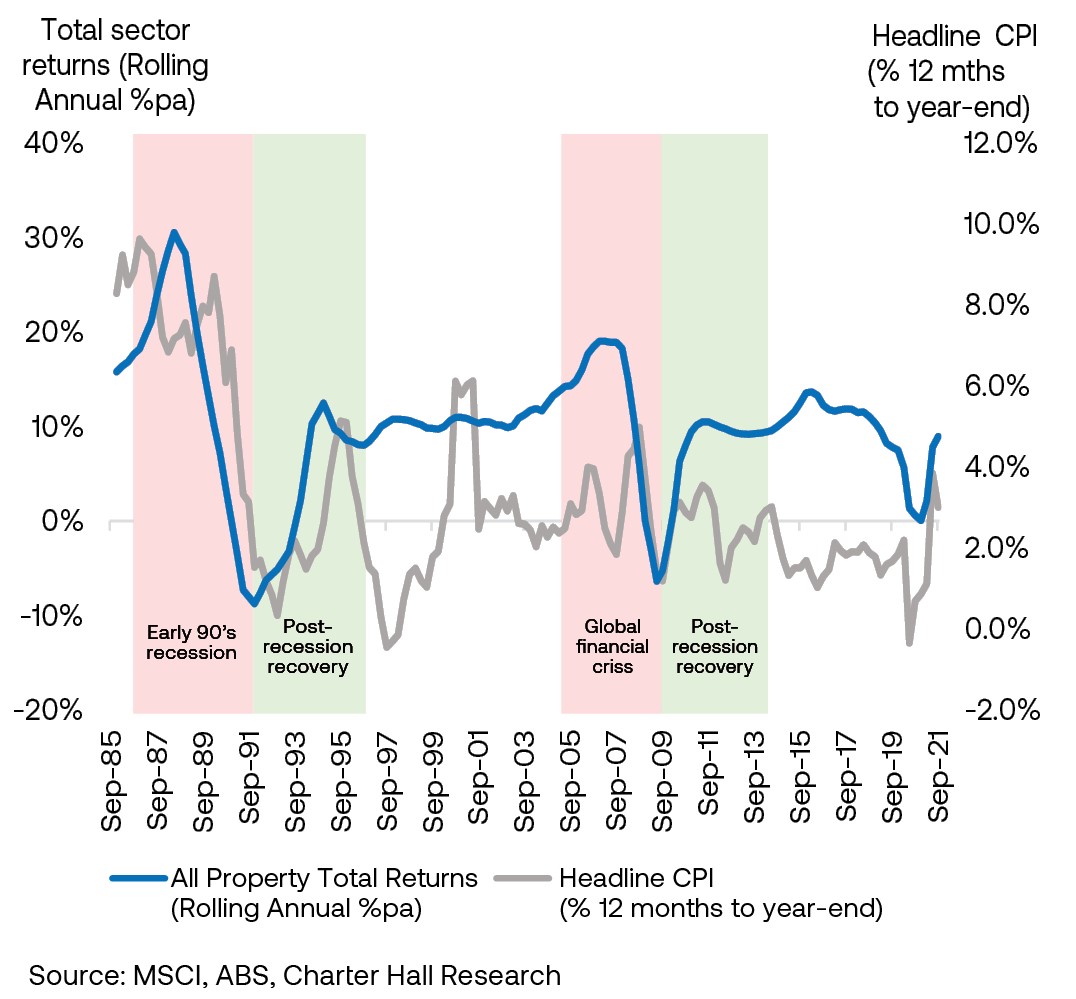
Allocations to real estate
This economic recession didn’t originate from the financial sector. As such, the real estate sector didn’t face the same issues relating to liquidity and the underlying confidence in asset valuation seen during past economic crashes. The global allocations to real estate, particularly across the Asia-Pacific region, continued to increase over the past year. This generates increased investor demand for commercial real estate assets across Australia.
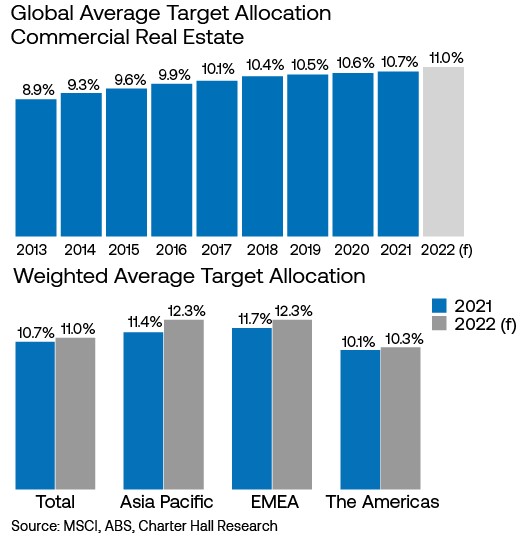
Inflation and commercial property
Real estate provides low correlation to other investments such as hedge funds, venture capital, private equity, private debt and other hard asset classes such as infrastructure1. As such, investors have sought real estate for the potential benefits of reducing volatility and potential risk. These factors have already translated into increased investor demand. Investment volumes in Australia across the industrial sector reached $18 billion over the year – well above the long-term average of $4.7 billion. Similarly, transaction volumes for the Office sector climbed to $15.9 billion over the past year, the highest level since 2019.
How has commercial real estate performed in periods of elevated inflation?
The charts below show how in periods of higher inflation you tend to find the annual returns of commercial real estate to also be high and elevated. This is a reasonably consistent relationship regardless of the underlying property sector. Commercial Real Estate has historically provided a solid hedge and performed well in periods where inflation increases against the backdrop of economic expansionary periods. As noted above though, other external market factors can also have larger influences on investment performance, including investor demand.
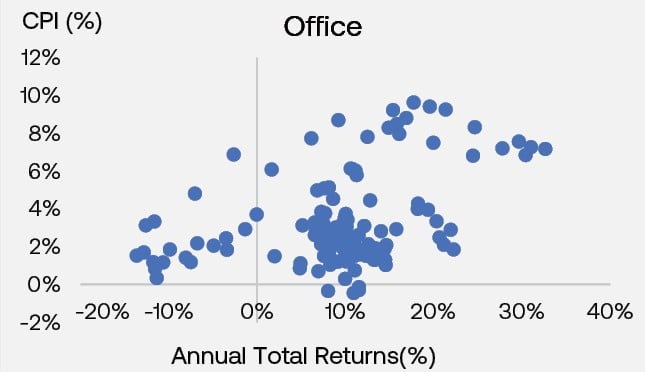 | 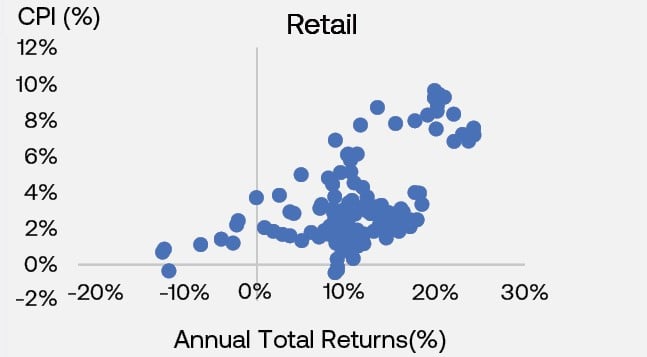 |
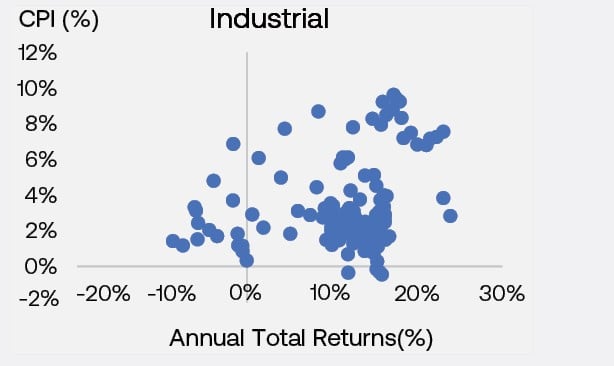 |
Outlook
Moderate inflation poses little risk to commercial property. At Charter Hall we focus on strategies that assist with the offset of any potential negative impacts from rising inflation. Including a focus on long leases with fixed reviews, interest rate hedging and importantly, high quality assets.
1. (PERE 2022) Look Ahead 2022 : Five reasons real estate allocation will rise next year Charts show quarterly returns between the periods of 1985 and 2021.
Source: MSCI, ABS, Charter Hall Research


